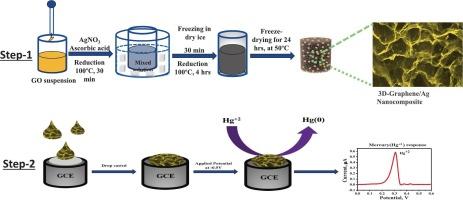agnp改性三维石墨烯电化学传感器超痕量测定汞离子的基本原理
Q1 Environmental Science
Environmental Nanotechnology, Monitoring and Management
Pub Date : 2025-07-31
DOI:10.1016/j.enmm.2025.101089
引用次数: 0
摘要
汞(Hg)是全球公认的高毒性重金属污染物,尽管在该领域取得了一些重要进展,但实际样品中Hg2+离子吸引水平的测定仍然是一个挑战。本文通过一种简单、经济、一步的冷冻铸造方法合成了三维石墨烯修饰的银纳米颗粒(AgNPs/ 3d -石墨烯),该方法已被用于高灵敏度的Hg2+测定。制备的AgNPs/3D-石墨烯纳米复合材料的形貌和结构表明其具有连续微米大小的开放孔和均匀装饰的平均尺寸为30 nm的银纳米颗粒的三维细胞网络结构。AgNPs/ 3d -石墨烯纳米复合材料修饰的GCE (AgNPs/ 3d -石墨烯/GCE)与Hg2+浓度在0.1 ~ 40 μg L−1范围内呈良好的线性关系。结果表明,该方法的检出限(LOD)为0.08 μ L−1 (S/N = 3),显著低于世界卫生组织(WHO)推荐阈值。采用标准物质(CRM)对方法进行了验证。这种复合材料的灵敏度和稳定性是通过3d -石墨烯网络上支架良好的AgNPs实现的,这使得该方法新颖,从其他报道中脱颖而出。该电化学传感器能很好地检测土壤和井水样品以及临床样品中的Hg2+,对保障人体健康具有重要意义。本文章由计算机程序翻译,如有差异,请以英文原文为准。

Rationale of AgNPsmodified 3-dimensional grapheneas electrochemical sensor for the ultra-tracedetermination of mercury ions
Mercury (Hg) is a globally accepted highly toxic heavy metal pollutant and despite several important developments in the field, the determination of Hg2+ ions attrace levels in real-world samples is a challenge. Herein, the silver nanoparticles modified with three-dimensional graphene (AgNPs/3D-graphene) nanocomposite has been synthesised through a simple, cost-efficient, one-step freeze-casting routethat has been applied for highlysensitive determination of Hg2+. The 3D cellular network structure with continuous micrometersize open pores and uniformly decorated Ag nanoparticles with an average size of 30 nm has been suggested by the morphologies and structures of the as-prepared AgNPs/3D-Graphene nanocomposite. The AgNPs/3D-graphene nanocomposite-modifiedGCE (AgNPs/3D-graphene/GCE) exhibited a good linear relationship with Hg2+ concentrations ranging from 0.1 to 40 μg L−1. The results showed that the limit of detection (LOD) of 0.08 μg L−1 (S/N = 3), which is significantly less than the World Health Organization’s (WHO) recommended threshold. The method validation has been carried out using certified reference material (CRM). The sensitivity and stability from the composite has been achieved from the well scaffolded AgNPs all along the 3D-graphene network, which has made the method novel and stand out from othere reported. The suggested electrochemical sensor performed well in detecting Hg2+ in soil and borewell water samples as well as in clinical samples, which is crucial in safeguarding human health.
求助全文
通过发布文献求助,成功后即可免费获取论文全文。
去求助
来源期刊

Environmental Nanotechnology, Monitoring and Management
Environmental Science-Water Science and Technology
CiteScore
13.00
自引率
0.00%
发文量
132
审稿时长
48 days
期刊介绍:
Environmental Nanotechnology, Monitoring and Management is a journal devoted to the publication of peer reviewed original research on environmental nanotechnologies, monitoring studies and management for water, soil , waste and human health samples. Critical review articles, short communications and scientific policy briefs are also welcome. The journal will include all environmental matrices except air. Nanomaterials were suggested as efficient cost-effective and environmental friendly alternative to existing treatment materials, from the standpoints of both resource conservation and environmental remediation. The journal aims to receive papers in the field of nanotechnology covering; Developments of new nanosorbents for: •Groundwater, drinking water and wastewater treatment •Remediation of contaminated sites •Assessment of novel nanotechnologies including sustainability and life cycle implications Monitoring and Management papers should cover the fields of: •Novel analytical methods applied to environmental and health samples •Fate and transport of pollutants in the environment •Case studies covering environmental monitoring and public health •Water and soil prevention and legislation •Industrial and hazardous waste- legislation, characterisation, management practices, minimization, treatment and disposal •Environmental management and remediation
 求助内容:
求助内容: 应助结果提醒方式:
应助结果提醒方式:


